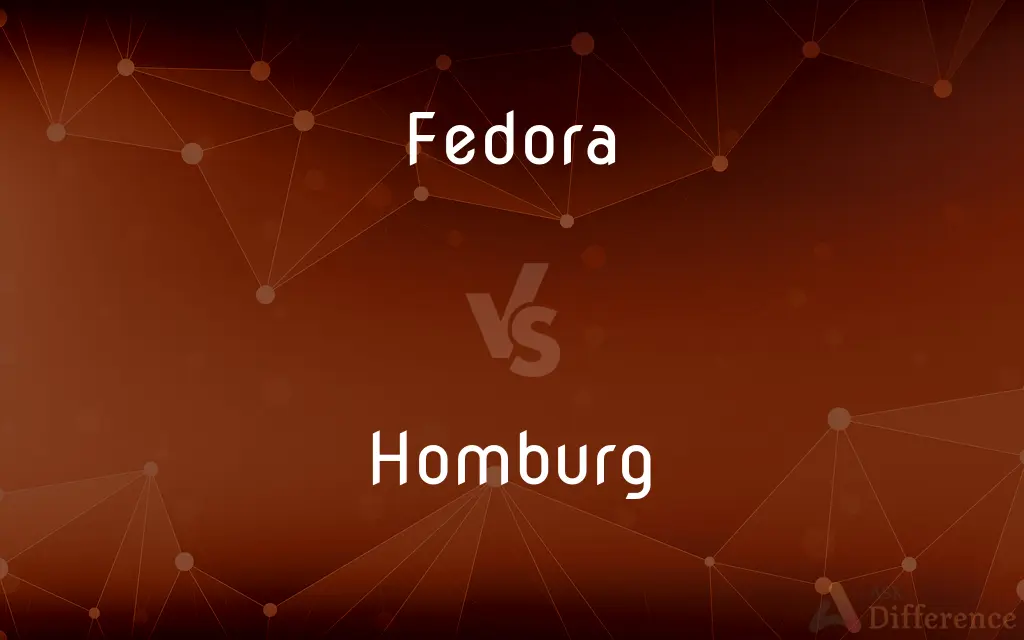Fedora vs. Homburg — What's the Difference?
By Tayyaba Rehman & Urooj Arif — Updated on March 8, 2024
A fedora is a soft, brimmed hat with a pinched front and a creased crown, while a Homburg is a formal hat with a single dent running down the center of the crown and a stiff, upturned brim.

Difference Between Fedora and Homburg
Table of Contents
ADVERTISEMENT
Key Differences
The fedora is characterized by its versatility and has been popular in various fashion eras, known for its indented crown and the ability to be shaped in several ways due to its soft brim. The Homburg, on the other hand, is known for its more rigid structure, offering a single, pronounced crease along the crown and a brim that is distinctly curled upwards on the edges, making it a staple in formal attire.
Fedora hats are often made from wool, felt, or even straw, allowing for a wide range of styles and suitable for both casual and formal occasions. The Homburg, traditionally made from stiff felt, is typically worn for more formal events, often associated with attire for business, formal social engagements, or by political figures.
The fedora's brim can vary in width, and it's commonly worn with the brim tilted slightly down at the front for a classic look, giving it a more casual or adventurous feel. The Homburg's brim is usually fixed and upturned, contributing to its more formal and structured appearance.
Historically, the fedora gained popularity in the early 20th century and was associated with a wide range of social classes, from city workers to gangsters, and later, a staple of Hollywood's leading men. The Homburg became popular in the late 19th century, notably worn by King Edward VII, and has since been associated with European aristocracy and international diplomats.
The choice between a fedora and a Homburg often depends on the occasion and personal style. The fedora offers more flexibility and a range of expressions, from the rugged to the refined, while the Homburg presents a distinguished, formal look, often chosen for its classic and authoritative presence.
ADVERTISEMENT
Comparison Chart
Crown
Pinched at the front with various possible creases.
Single, pronounced crease down the center.
Brim
Soft and shapeable, can be worn up or down.
Stiff and upturned, providing a formal silhouette.
Material
Made from wool, felt, straw, allowing for flexibility.
Traditionally made from stiff felt for a structured look.
Occasion
Suitable for both casual and formal occasions.
Primarily worn at formal events and ceremonies.
Historical Popularity
Popular among a wide range of social classes in the 20th century.
Favored by European aristocracy and political figures since the late 19th century.
Compare with Definitions
Fedora
A versatile hat with a soft brim and indented crown.
He chose a grey fedora to complete his casual look.
Homburg
Known for its elegance and association with high-status individuals.
The diplomat's Homburg added to his authoritative presence.
Fedora
Can be styled in multiple ways, appealing to various fashion tastes.
She tilted her fedora's brim for a touch of mystery.
Homburg
Typically seen in traditional, formal settings.
The Homburg is a preferred choice for state ceremonies.
Fedora
Associated with a wide range of cultural icons and eras.
The fedora became iconic, thanks to its association with 1940s film noir.
Homburg
A formal hat distinguished by its rigid structure and curled brim.
He wore a black Homburg to the formal dinner.
Fedora
Popular in both men's and women's fashion.
The fedora added a classic edge to her modern outfit.
Homburg
Symbolizes a classic, refined fashion statement.
Opting for a Homburg, he embraced a timeless look for the wedding.
Fedora
Often made from materials like wool or felt, suitable for different seasons.
His summer wardrobe included a lightweight straw fedora.
Homburg
Made from stiff felt, maintaining its shape over time.
The quality felt of his Homburg ensured its longevity.
Fedora
A fedora is a hat with a soft brim and indented crown. It is typically creased lengthwise down the crown and "pinched" near the front on both sides.
Homburg
A felt hat having a soft dented crown and a shallow, slightly rolled brim.
Fedora
A soft felt hat with a fairly low crown creased lengthwise and a brim that can be turned up or down.
Homburg
Alternative case form of Homburg
Fedora
A felt hat with a fairly low, creased crown with a brim that can be turned up or down.
Homburg
A felt hat with a crown that is creased lengthwise, and a brim that is slightly curled upward at the edge.
Fedora
A soft felt hat with a crown creased lengthwise.
Homburg
Felt hat with a creased crown
Fedora
Felt hat with a creased crown
Common Curiosities
How do I care for a fedora?
Store it in a cool, dry place and use a soft brush to remove dust. Avoid handling the crown too much to maintain its shape.
Can women wear Homburg hats?
Yes, women can wear Homburg hats, especially for formal occasions, though they are more traditionally worn by men.
Can a fedora be worn with casual attire?
Yes, a fedora can be styled with both casual and formal attire, making it a versatile accessory.
Were fedoras originally designed for men or women?
Fedoras were initially marketed towards women but gained popularity among men in the early 20th century.
Is a Homburg suitable for everyday wear?
While primarily a formal hat, personal style and occasion can dictate the suitability of a Homburg for everyday wear.
How do I choose between a fedora and a Homburg?
Consider the occasion and your personal style; a fedora for versatility and a Homburg for a formal statement.
Is there a cultural significance to wearing a Homburg?
The Homburg is often associated with formality and authority, historically worn by European aristocracy and leaders.
Are there different brim sizes for fedoras?
Yes, fedoras come with various brim widths, from narrow to wide, allowing for different stylistic choices.
Can a Homburg be reshaped if it loses form?
Due to its stiff felt construction, a Homburg should retain its shape well, but professional millinery services can help with reshaping if needed.
What's the significance of the colors in fedoras and Homburgs?
Color choices can reflect personal style or the formality of an event, with darker colors typically being more formal.
Share Your Discovery

Previous Comparison
Move vs. Travel
Next Comparison
Bakelite vs. PlasticAuthor Spotlight
Written by
Tayyaba RehmanTayyaba Rehman is a distinguished writer, currently serving as a primary contributor to askdifference.com. As a researcher in semantics and etymology, Tayyaba's passion for the complexity of languages and their distinctions has found a perfect home on the platform. Tayyaba delves into the intricacies of language, distinguishing between commonly confused words and phrases, thereby providing clarity for readers worldwide.
Co-written by
Urooj ArifUrooj is a skilled content writer at Ask Difference, known for her exceptional ability to simplify complex topics into engaging and informative content. With a passion for research and a flair for clear, concise writing, she consistently delivers articles that resonate with our diverse audience.
















































